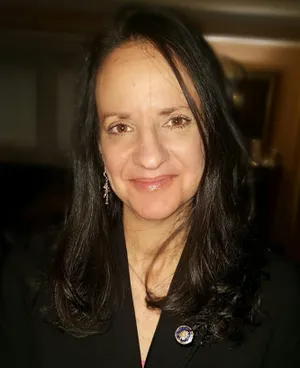Teaching About Real-World, Transdisciplinary Problems and Phenomena through Convergence Education
In its 2018 Federal STEM Strategic Plan, a collaboration of government agencies wrote that science, technology, engineering, and mathematics (STEM) education should move through a pathway where disciplines “converge” and where teaching and learning moves from disciplinary to transdisciplinary. Classroom examples help spotlight what this framework can look like in practice.
:focal(356x275:357x276)/https://tf-cmsv2-smithsonianmag-media.s3.amazonaws.com/filer_public/4f/18/4f18e5c8-9a86-4a92-9668-2de7e8c3cdac/picture1.jpg)
In today’s K-12 classrooms, students are learning a lot more than just reading, writing, and arithmetic. Today, problem- and phenomenon-based learning means that students are tackling some of the most complex topics of our times, whether it is cybersecurity, innovation and entrepreneurship, climate change, biodiversity loss, infectious disease, water scarcity, energy security, food security, or deforestation. Educators are using transdisciplinary learning to help students address deep scientific questions and tackle broad societal needs.
Convergence Education
But how does an educator, who is assigned to teach one discipline (e.g., reading, writing, math, science, social studies, or art) bring together multiple disciplines to teach about complex socio-scientific problems or opportunities? Researchers at the National Science Foundation (NSF) call this “convergence”, and say that it has three primary characteristics:
- It is driven by a specific and compelling problem (such as climate change) or opportunity (such as entrepreneurship and innovation); and, it arises from:
- A deep scientific phenomenon (that is, an observable event or happening that can be explained, such as clean groundwater);
- An emerging problem (that is, something that can be solved through the development of an object, tool, process or system and includes multiple criteria and constraints, such a new water filtration system); or,
- A pressing societal need (that is, a need to help people and society, such as ensuring all community members have access to clean water to stay healthy).
- It has deep integration across multiple disciplines. This is important because complex socio-scientific problems and phenomena cannot be explained or solved by looking at them through one perspective (e.g., environmental, social, economic, or ethical). Instead, experts from different disciplines must work together to blend their knowledge, theories, and expertise to come up with a comprehensive solution.
- Finally, it is transdisciplinary. That means no one discipline can solve the problem on its own.
From Disciplinary to Transdisciplinary
What do we mean by “transdisciplinary?” In its Federal STEM Strategic Plan, a collaboration of government agencies wrote in 2018 that science, technology, engineering, and mathematics (STEM) education should move through a pathway where disciplines converge and where teaching and learning moves from disciplinary to transdisciplinary. They wrote:
“Problems that are relevant to people’s lives, communities, or society, as a whole, often cross disciplinary boundaries, making them inherently engaging and interesting. The transdisciplinary integration of STEM teaching and learning across STEM fields and with other fields such as the humanities and the arts enriches all fields and draws learners to authentic challenges from local to global in scale.” (OSTP, 2018, p 20)
STEAM education expert and author Joanne Vasquez, former Executive Director of the National Science Teaching Association (NSTA), and her co-authors explain it this way:
- Disciplinary – Students learn concepts and skills separately in isolation.
- Multidisciplinary – Students learn concepts and skills separately in each discipline but in reference to a common theme.
- Interdisciplinary – Students learn concepts and skills from two or more disciplines that are tightly linked so as to deepen knowledge and skills.
- Transdisciplinary – By undertaking real-world problems or explaining phenomena, students apply knowledge and skills from two or more disciplines to help shape the learning experience.
/https://tf-cmsv2-smithsonianmag-media.s3.amazonaws.com/filer_public/4f/b9/4fb93ac6-dbf3-4880-8190-84480d0dbeb5/picture2.png)
A Classroom Example
Let’s try an example, using images selected by one of the co-authors who is a master STEAM teacher and former Einstein Fellow at the U.S. Department of Energy, Kelly J. Day. Imagine you were teaching about plants so that your students can help people experiencing food insecurities in their community. This requires fundamental disciplinary knowledge about science, mathematics, social studies, civic engagement, and entrepreneurship. What would it look like to move along the pathway to convergence, from disciplinary to transdisciplinary teaching and learning?
/https://tf-cmsv2-smithsonianmag-media.s3.amazonaws.com/filer_public/63/bd/63bd8e71-9b31-4bad-9e1b-683fb25da753/analogyconvergence.png)
- Using a disciplinary approach, a science teacher might ask students to examine the properties of soil or have students study how tomato seeds germinate in each soil type. In this case, the teacher is identifying an isolated concept (fact, idea, or practice) that is aligned with only one discipline (e.g., science).
- Using a multidisciplinary approach, a math teacher might ask the students who learned about soil properties and tomato seed germination in science class, to calculate in math class the cost of buying 1 pound of soil, 20 packets of tomato seeds, 10 packets of pepper seeds, and 3 garden tools. The concept now involves multiple disciplines addressed independently on different aspects of the same concept.
- Using an interdisciplinary approach, multiple teachers—for example, one social studies, one science, and one math—might work together to have students plant a variety of seeds in different soil types to grow vegetables on the school grounds. Each teacher would ask students to contribute to the collective problem—studying soil properties and seed germination in their science class; calculating the cost of the materials in their math class; and finally, drawing a map of the local school grounds in their social studies class to help decide where to place the garden based on geographic direction. In this case, students and teachers across disciplines work together in an integrated way that makes the concept more authentic and real-world (but, like the salad shown here, you can still identify the individual component disciplines or parts).
- Finally, using a transdisciplinary approach, you would walk into any one classroom and not be able to tell which discipline(s) are being taught because they have “converged.” For example, students might be asked to come up with an entrepreneurial project to raise funds for those in need in their local community. They decide to design and build a garden so they can make and sell salsa, while also helping people experiencing food insecurities in their community. In this case, students identify a complex real-world problem and work together to create a shared approach to identifying the phenomenon or solving the problem.
A Pathway to Convergence
Teaching for convergence is not about replacing disciplinary teaching with transdisciplinary teaching; instead, it is about a pathway to convergence. Students, especially in the early grades, still require a strong foundation of disciplinary knowledge and skills. The transition along the pathway to convergence, from disciplinary to transdisciplinary teaching and learning, does not just happen—it is intentional, explicit, and measured.
Transdisciplinary teaching and learning that leads students along a pathway to convergence has many different names that you may be familiar with already—phenomenon-based learning, problem-based learning, place-based learning, project-based learning, civic engagement, inquiry-based learning, entrepreneurship education, and applied learning. No matter what you call it, this type of teaching is important to prepare today’s students for tomorrow’s complex world. And it is becoming more common in schools, despite the barriers that exist in the U.S. (e.g., aligning with standards; finding time in the curriculum; finding common planning time to collaborate with other teachers).
/https://tf-cmsv2-smithsonianmag-media.s3.amazonaws.com/filer_public/1f/12/1f12b463-848a-4fac-a6e3-65b2742c0932/global_goals.png)
Free Teaching Resources
The Smithsonian and other federal agencies that support STEAM teachers are here to help. We develop resources to support educators as they move from disciplinary to transdisciplinary teaching and learning along the pathway to convergence. At the Smithsonian, for example, we have a front door to discoveries in science, history, art, and culture. We bring these disciplines together by integrating inquiry-based science education, civic engagement, place-based education, global citizenship education, and education for sustainable development, so that students can engage in local action for global goals, whether it is about food security or environmental justice.
Convergence education and a transdisciplinary approach to teaching and learning helps students develop critical reasoning skills, systemic understanding of complex issues, scientific literacy, perspective taking, and consensus building, all as they plan and carry out local actions for social good. Teachers and students across the country, with the support of the Smithsonian and other federal partners, are tackling the most pressing environmental and social issues of our time, supporting young students as they take action to address complex global issues, and helping them find solutions that address societal needs through convergence education.
Acknowledgement: This article is based on the work of the Federal Coordination in STEM Education (FC-STEM) Interagency Working Group on Convergence, under the direction of Quincy Brown and Nafeesa Owens of the Office of Science and Technology Policy. The IWG is co-led by Louie Lopez and Jorge Valdes, with support from Executive Secretary Emily Kuehn.
Editor's Note: To learn more about the Convergence Education framework, join Carol O’Donnell and Kelly J. Day, along with a panel of federal educators and practitioners at the Smithsonian's National Education Summit on July 27-28, 2022. More information is available here: https://s.si.edu/EducationSummit2022

